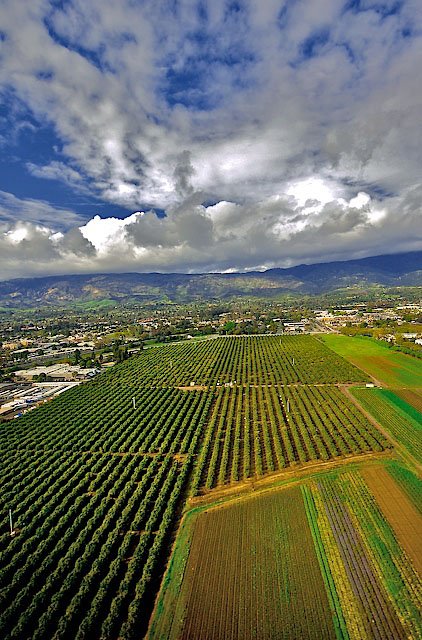The establishment of Mission San Buenaventura in 1782 marked the beginning of agriculture in our region. The climate was ideally suited to the crops that the Spanish knew well from centuries of cultivation in their homeland, as well as some others discovered during the era of Spanish exploration. The Mission soon sprouted gardens, orchards, and vineyards. Captain George Vancouver of the British Royal Navy anchored off Ventura in 1792 and paid a visit to the Mission. While there he noted peach, apricot, fig, pear, apple and orange trees, as well as grapevines, pomegranates, and bananas.
Despite the benign climate and wonderful soils, it did not take long for the Spanish to discover one of the enduring realities of agriculture and settlement in California: water is limited. The solution for the Spanish, as for later generations of Californians, was to move the water to where they needed it. While the exact date of completion is subject to dispute, a seven-mile long aqueduct, built with local stone and mortar, was in operation by the early 1800’s. This structure supplied water from the Ventura River to the Mission settlement and its residents. Portions of this aqueduct are still visible near the mouth of Cañada Larga, near Highway 33.

The mission era remains the one brief period during which Ventura was largely independent of the rest of the agricultural world. The Spanish crown supported the expansion of the mission system and the Catholic faith, but ultimately had an eye on economics. Grants of land were intended to extend the crown’s power in both political and commercial terms. The first land grant in what would become Ventura County was Rancho Simi; 113,000 acres granted in 1795. Present day Simi Valley and Moorpark fall within this original Rancho’s boundaries. It was followed by Rancho El Conejo, a 48,000 grant in 1802 that includes contemporary Thousand Oaks and Newbury Park.
Mexican independence from Spain unleashed the economic potential of the Rancho system. Spain had insisted that California could trade only with Spanish vessels, but this put an artificial constraint on the productive capacity of the region. Mexico was open to trade, so 1821 brought not only independence, but Yankee sailors and merchants seeking new goods and new markets. Within ten years, California was prospering from the “hide and tallow” trade, providing raw materials to a global market. Today we easily understand the use of hides for leather, but the value of tallow for candles and soap is not readily known. But these two humble commodities built fortunes… some locally, but mostly for New England traders.
Additional land grants from the Mexican government began to shape the county we now know after the secularization of most mission acreage in 1834. These embraced the hide and tallow trade as well, which reached a crescendo a decade and a half later as California was flooded with fortune seekers during the Gold Rush. Not only did this spur demand for leather goods and tallow, it created a market for dried and salted beef. The massive influx of population, and Mexican defeat in the Mexican-American War, put California on the fast track to statehood in the rapidly expanding United States.
The Treaty of Guadalupe Hidalgo recognized the legitimacy of the Spanish and Mexican land grants, but the Rancheros soon found themselves in a position familiar to farmers through the ages: land rich and cash poor. But California was filled with men drifting away from the gold fields and looking for land, and piece by piece the Ranchos began to be dismantled and sold to these newly arrived American farmers.
Different eyes often see different opportunities, and this was the case for the new farms carved from the Ranchos. Focus turned to grains, and by the 1860’s, barley had emerged as the region’s leading crop. Severe droughts in 1863-64 and 1876-77 put further stress on cattle and their masters, and lead to the sale of even more land to the grain farmers. Eventually the Oxnard plain was dominated by barley, wheat, oats, and corn.

Even while grain ruled the Oxnard Plain, the game was changing yet again. Grain production was also surging in Canada and Russia. Soon global grain markets were saturated, depressing prices. Ventura County growers adapted with remarkable speed, turning from grain to walnuts, lima beans and sugar beets. But the biggest change of all was the arrival of the Railroad, linking Ventura with population centers on the East Coast.




